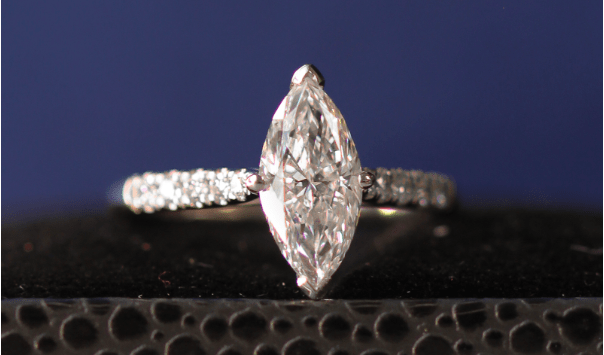Top Tips for Choosing the Perfect Marquise Cut Diamond
One of the most important things to consider when shopping for a piece of diamond jewellery is the cut as it can play a key factor in the beauty and brilliance of the stone. When it comes to diamond cuts that stand out from the crowd, look no further than the marquise cut.
Marquise diamonds (also known as navette diamonds) are not only steeped in royalty, but are both beautiful and elegant. This diamond cut has been around for centuries and was invented in France, featuring pointed ends and curved sides, giving it a unique and distinctive shape.
We’ve put together some top tips to guide you through the process of choosing the perfect marquise cut diamond.
What is a Marquise Cut Diamond?
A marquise cut diamond is cut in a shape that looks similar to an eye, boat or a rugby ball and has pointed ends.
Compared to other diamond shapes, a marquise diamond is not as traditional as a princess or round cut, but each gem has its own distinctive shape. The long, narrow shape of a marquise diamond can create the illusion of a larger diamond being worn. If you are looking to stand out from the crowd, then consider getting yourself a marquise engagement ring or diamond marquise ring.
Is a Marquise Diamond a Good Cut?
Yes, a marquise diamond is considered a good cut due to how versatile it is, making it perfect for vintage-style and solitaire pieces.
A marquise cut is ideal for showing off the stone’s brilliance and the shape gives the illusion of being larger than its actual carat weight. The elongated shape of the marquise cut is also extremely flattering making the fingers of the wearer appear longer and more slender.
However, it is important to note that the beauty of a marquise cut diamond depends on its craftsmanship and quality, so it is essential to choose carefully.
How Many Facets are in a Marquise Cut Diamond?
Marquise diamonds typically have 57 triangular and kite-shaped facets, which make up the entire stone’s shape. There are 33 facets on the crown and 24 on the pavilion, thus enhancing the diamond’s sparkle and brilliance. Compared to a brilliant round cut, the Marquise diamond may have between four, six or eight main facets on the gem.
Symmetry is Key
When selecting a marquise cut diamond, symmetry plays a vital role in its overall beauty.
The two halves of the diamond should mirror each other, and the pointed ends should align perfectly. Look for a well-balanced marquise cut diamond with symmetrical curves and a centred table. Avoid diamonds with noticeable asymmetry, as it can affect the diamond’s overall appearance and brilliance.
Consider the Shape of the Diamond
While marquise cut diamonds generally have a long and slender shape, they can vary in their proportions.
It’s important to consider the length-to-width ratio, which indicates the diamond’s overall shape. The ideal length-to-width ratio for a marquise cut diamond ranges between 1.70 and 2.15. However, personal preference should also be taken into account, as some may prefer a more elongated or rounded shape.
Look Out for the Bowtie Effect
The bowtie effect is a common phenomenon seen in marquise cut diamonds. It refers to a dark, bowtie-shaped shadow that appears in the centre of the diamond when light fails to reflect properly. While a slight bowtie can be acceptable, it is crucial to choose a marquise cut diamond with as little bowtie as possible to ensure its overall brilliance and beauty.
Buy a Stunning Piece of Marquise Cut Diamond Jewellery from Shining Diamonds
Wondering where to begin with your journey to buying a beautiful piece of marquise cut diamond jewellery? Our experts will answer your questions and advise you on finding the right marquise diamond engagement ring, earrings or pendant for you or someone special in your life. Book an appointment today at one of our showrooms, whether that’s London’s Hatton Garden or Brighton’s The Lanes showroom and buy yourself a stunning piece of marquise cut diamond jewellery.




